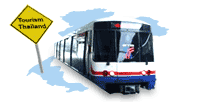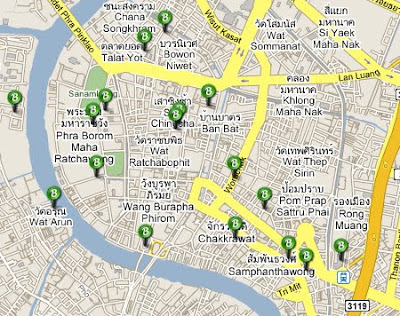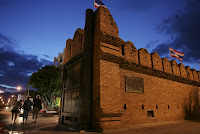 How to get there ??? By Car from Bangkok
How to get there ??? By Car from Bangkok (approximately 8 hours)
Route 1: Drive on Highway No.1 (Phahonyothin) and turn left to Highway No.32 (Asian Highway) which passes Phra Nakhon Si Ayutthaya, Ang Thong, and Nakhon Sawan, then take Highway No. 117 to Phitsanulok and Highway No. 11 to Lampang, Lamphun and Chiang Mai. The total distance is 695 kilometers.
Route 2: From Nakhon Sawan, take Highway No. 1 passing Kamphaeng Phet, Tak, Lampang, and Chiang Mai. Total distance is 696 kilometers.
 By Bus
By Bus
From BangkokThere are ordinary, 2nd class and 1st class air-conditioned buses leaving for Chiang Mai daily (8.00 a.m. to 09.00 p.m.) from the Bangkok's Northern Bus Terminal (Mochit 2 Bus Terminal). Call 02 936 3600, 02 936 2852, and 02 937 8055 for a more updated bus timetable. Private buses, which can be conveniently booked in tourist-oriented places in Bangkok, are also available. However, the public buses from the Northern Bus Terminal are generally more reliable. The journey takes approximately 10-12 hours, depending on traffic.
From Chiang MaiIf you travel to any districts in Chiang Mai, use Chang Phuak Bus Terminal located on Chotana Road, tel. 053 211 586. Destinations include those located along the northern route (Highway No. 107) which passes through Mae Rim, Mae Taeng, Chiang Dao, Chaiprakan, Fang and Mae Ai. Some buses continue to Tha Ton, the northern-most province of Chiang Mai.
If you wish to travel outside the province, use Chiang Mai Arcade Bus Station. Contact tel: 0 5324 2664 for a more updated bus timetable. Destinations include Golden Triangle, Mae Sai, Chiang Saen, Chiang Rai, Nan, Phayao, Phrae, Lampang, Lamphun, Phitsanulok, Sukhothai, Mae Hong Son (both old and new routes), Mae Sot, Mae Sariang, Khon Kaen, Nakhon Ratchasima (Khorat), and Udon Thani.
 By Train
By TrainExpress and rapid trains operated by the State Railways of Thailand leave for Chiang Mai from Bangkoks Hua Lamphong Station 6 times a day from 8.00 a.m.-10.00 p.m. The trip takes about 11-12 hours for express trains. For more information, contact tel. 1690, or 02 223 7010, 02 223 7020. Chiang Mai Railway Station, tel. (053) 24 2094, 244 795, .247 462 245 363-4
 By Air
By AirDomestic airlines including Thai Airways, Bangkok Airways, Air Asia, Nok Air, Orient Thai Airlines, Air Andaman and Phuket Air operate several flights daily between Bangkok and Chiang Mai.
Thai Airways also operates domestic flights from Chiang Mai to Mae Hong Son, Chiang Rai and Phuket. International flights to and from Chitakong, Luang Phrabang, Khunming, Yangon and Japan (Narita) are also provided. Call 02 628 2000 (Bangkok), 053 211 044-7 (Chiang Mai), or visit www.thaiairways.com for more information.
Bangkok Airways also offers several flights daily on the Bangkok - Chiang Mai route, some with a stopover at Sukhothai. International routes to and from Jinghong and XiAn are also available. Call 02 265 5555, 265 5678 (Bangkok Office) or 053 27 6176 (Chiang Mai Office) or visit www.bangkokair.com for more information.
SGA offers flights to Chiang Mai. For more information, call Bangkok Office 66 2664-6099 or visit: www.sga.co.th
For Nok Air call 1318 or visit www.nokair.co.th for reservations. Apart from Bangkok-Chiang mai flight, the airlines also operate flights between Chiang mai and Udon Thani twice aweek. For the flights Chiang Mai-Chiang Rai, Chiang Mai-Mae Hong Son, and Chiang Mai-Pai, please visit www.nokmini.com.
For Orient Thai Airlines, call 02 267 2999 or visit www.orient-thai.com for more information.
Foreign Airlines operating flights from Chiang Mai to several destinations are:
Air Mandalay operates flights between Chiang Mai and Yangon on Sundays and Thursdays. Contact 053 818 049 (Chiang Mai office), visit www.myanmars.net/airmandalay or write to cnxrr6t@sita.gmsmail.com for more information.
Mandarin Airlines operates flights between Chiang Mai and Taipei three times a week on Tuesday, Friday and Saturday. For more information call, 053 201 268-9 (Chiang Mai office) or visit www.mandarinair.com
Lao Airlines operates flights on the Chiang Mai Luang Phrabang route three times a week on Tuesday, Friday and Sunday. Call 053 223 401 (Chiang Mai office), visit www.laoairlines.com or write to qvcnx@loxinfo.co.th for more information.
Silk Air operates flights between Chiang Mai Singapore three times a week on Tuesday, Friday and Sunday. Call 053 276 459 053 276 495 (Chiang Mai office) or visit www.silkair.com for reservations.
Travelling within Chiang Mai
From Airport, Train and Bus Terminal to town
There is a licensed airport taxi service available at the taxi kiosk outside the baggage-claim area. Purchase a ticket and present it to the drivers waiting by the arrivals exit area. The trip will cost approximately 100 bahts for a sedan car that seats 4-5 people (with luggage).
From the airport, train station and bus terminal, you can easily get a song taew (red mini-bus). To charter a minibus or car, please check the correct fare at the TAT counter first.
Normally, first-class hotels provide complimentary transportation between the airport, railway station or bus terminals and the hotel for guests who have made advance reservations.
Short-distance travel1. For relative short distances you can take a sam lor or tuk-tuk (a tricycle). Fares must be bargained in advance. Short rides within the city costs between 20 and 30 bahts. Longer rides may cost as much as 50 bahts.
2. Just new in town is the taxi-metre, the same as those running around Bangkok. The minimum (starting) fare is 35 bahts.
3. Song taew (red mini-bus) is the most common means of transportation in town. Passengers can hop in and out as they wish. Simply tell the driver the destination and negotiate the price before boarding. Fares range from 10-20 bahts depending on the distance.
4. Bicycles
Some travelers prefer to ride a bicycle around the city as most of the roads and alleys are accessible by bicycle. Bicycles can be rented from bicycle shops and certain guesthouses.
5. Rental cars
All major car rental companies such as AVIS, Budget, and Hertz, as well as Thai car rental companies are ready to provide suggestions on travel itineraries. The easiest way to locate a car rental company is to ask at the airport or the hotel, as those are the places where most companies are located.
Chiang Mai roads are in good condition with signs posted in English. Why not take a car for a spinω
 BUS
BUS TAXI
TAXI TUK-TUKS
TUK-TUKS BTS Sky Trains
BTS Sky Trains Subway (Metro)
Subway (Metro) Boat
Boat


















